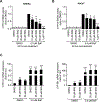The Toll-like receptor agonist imiquimod is metabolized by aryl hydrocarbon receptor-regulated cytochrome P450 enzymes in human keratinocytes and mouse liver
- PMID: 31111189
- PMCID: PMC11088943
- DOI: 10.1007/s00204-019-02488-5
The Toll-like receptor agonist imiquimod is metabolized by aryl hydrocarbon receptor-regulated cytochrome P450 enzymes in human keratinocytes and mouse liver
Abstract
The Toll-like receptor 7 agonist imiquimod (IMQ) is an approved drug for the topical treatment of various skin diseases that, in addition, is currently tested in multiple clinical trials for the immunotherapy of various types of cancers. As all of these trials include application of IMQ to the skin and evidence exists that exposure to environmental pollutants, i.e., tobacco smoke, affects its therapeutic efficacy, the current study aims to elucidate the cutaneous metabolism of the drug. Treatment of human keratinocytes with 2.5 µM benzo[a]pyrene (BaP), a tobacco smoke constituent and aryl hydrocarbon receptor (AHR) agonist, for 24 h induced cytochrome P450 (CYP) 1A enzyme activity. The addition of IMQ 30 min prior measurement resulted in a dose-dependent inhibition of CYP1A activity, indicating that IMQ is either a substrate or inhibitor of CYP1A isoforms. Incubation of 21 recombinant human CYP enzymes with 0.5 µM IMQ and subsequent LC-MS analyses, in fact, identified CYP1A1 and CYP1A2 as being predominantly responsible for IMQ metabolism. Accordingly, treatment of keratinocytes with BaP accelerated IMQ clearance and the associated formation of monohydroxylated IMQ metabolites. A co-incubation with 5 µM 7-hydroxyflavone, a potent inhibitor of human CYP1A isoforms, abolished basal as well as BaP-induced IMQ metabolism. Further studies with hepatic microsomes from CD-1 as well as solvent- and β-naphthoflavone-treated CYP1A1/CYP1A2 double knock-out and respective control mice confirmed the critical contribution of CYP1A isoforms to IMQ metabolism. Hence, an exposure to life style-related, dietary, and environmental AHR ligands may affect the pharmacokinetics and, thus, treatment efficacy of IMQ.
Keywords: Aryl hydrocarbon receptor; Cytochrome P450; Imiquimod; Immunotherapy; Psoriasis.
Conflict of interest statement
Conflict of Interests
The authors declare no existing conflicts of interest regarding the publication of this paper.
Figures




Similar articles
-
The relationship between DNA adduct formation by benzo[a]pyrene and expression of its activation enzyme cytochrome P450 1A1 in rat.Environ Toxicol Pharmacol. 2013 Nov;36(3):989-96. doi: 10.1016/j.etap.2013.09.004. Epub 2013 Sep 17. Environ Toxicol Pharmacol. 2013. PMID: 24095716
-
Molecular mechanisms of cold-induced CYP1A activation in rat liver microsomes.J Physiol Biochem. 2011 Dec;67(4):499-510. doi: 10.1007/s13105-011-0095-1. Epub 2011 Apr 20. J Physiol Biochem. 2011. PMID: 21505853
-
JNK inhibitor SP600125 is a partial agonist of human aryl hydrocarbon receptor and induces CYP1A1 and CYP1A2 genes in primary human hepatocytes.Biochem Pharmacol. 2008 Jan 15;75(2):580-8. doi: 10.1016/j.bcp.2007.09.013. Epub 2007 Sep 16. Biochem Pharmacol. 2008. PMID: 17959153
-
Cytochrome P450 1 family and cancers.J Steroid Biochem Mol Biol. 2015 Mar;147:24-30. doi: 10.1016/j.jsbmb.2014.11.003. Epub 2014 Nov 6. J Steroid Biochem Mol Biol. 2015. PMID: 25448748 Review.
-
Biological roles of cytochrome P450 1A1, 1A2, and 1B1 enzymes.Arch Pharm Res. 2021 Jan;44(1):63-83. doi: 10.1007/s12272-021-01306-w. Epub 2021 Jan 23. Arch Pharm Res. 2021. PMID: 33484438 Review.
Cited by
-
Rapamycin Alleviates 2,3,7,8-Tetrachlorodibenzo-p-dioxin-Induced Aggravated Dermatitis in Mice with Imiquimod-Induced Psoriasis-Like Dermatitis by Inducing Autophagy.Int J Mol Sci. 2021 Apr 12;22(8):3968. doi: 10.3390/ijms22083968. Int J Mol Sci. 2021. PMID: 33921372 Free PMC article.
-
Aryl Hydrocarbon Receptor in Atopic Dermatitis and Psoriasis.Int J Mol Sci. 2019 Oct 31;20(21):5424. doi: 10.3390/ijms20215424. Int J Mol Sci. 2019. PMID: 31683543 Free PMC article. Review.
-
Promoting New Approach Methodologies (NAMs) for research on skin color changes in response to environmental stress factors: tobacco and air pollution.Front Toxicol. 2023 Oct 10;5:1256399. doi: 10.3389/ftox.2023.1256399. eCollection 2023. Front Toxicol. 2023. PMID: 37886123 Free PMC article. Review.
-
Trajectory Shifts in Interdisciplinary Research of the Aryl Hydrocarbon Receptor-A Personal Perspective on Thymus and Skin.Int J Mol Sci. 2021 Feb 12;22(4):1844. doi: 10.3390/ijms22041844. Int J Mol Sci. 2021. PMID: 33673338 Free PMC article. Review.
-
Assessing cytochrome P450 function using genetically engineered mouse models.Adv Pharmacol. 2022;95:253-284. doi: 10.1016/bs.apha.2022.05.008. Epub 2022 Jun 30. Adv Pharmacol. 2022. PMID: 35953157 Free PMC article. Review.
References
-
- Ahmad N, & Mukhtar H (2004). Cytochrome p450: a target for drug development for skin diseases. J Invest Dermatol 123: 417–425. - PubMed
-
- Arpiainen S, Raffalli-Mathieu F, Lang MA, Pelkonen O, & Hakkola J (2005). Regulation of the Cyp2a5 gene involves an aryl hydrocarbon receptor-dependent pathway. Mol Pharmacol 67: 1325–1333. - PubMed
-
- Baron JM, Holler D, Schiffer R, Frankenberg S, Neis M, Merk HF, et al. (2001). Expression of multiple cytochrome p450 enzymes and multidrug resistance-associated transport proteins in human skin keratinocytes. J Invest Dermatol 116: 541–548. - PubMed
-
- Berghofer B, Frommer T, Haley G, Fink L, Bein G, & Hackstein H (2006). TLR7 ligands induce higher IFN-alpha production in females. J Immunol 177: 2088–2096. - PubMed
Publication types
MeSH terms
Substances
Grants and funding
LinkOut - more resources
Full Text Sources
Research Materials

